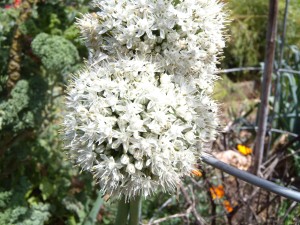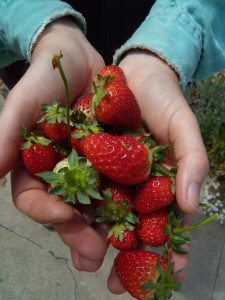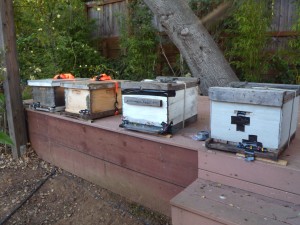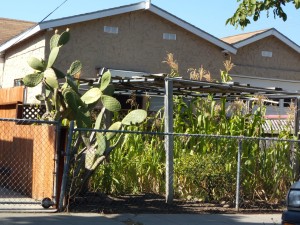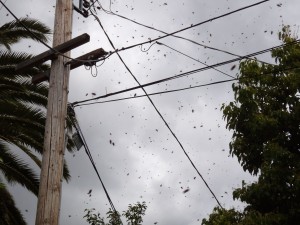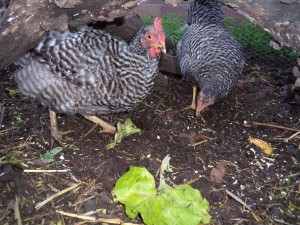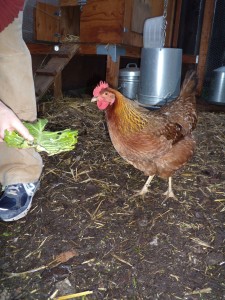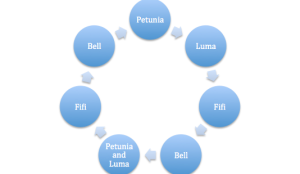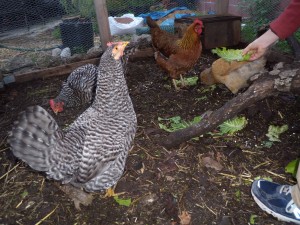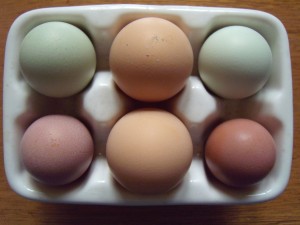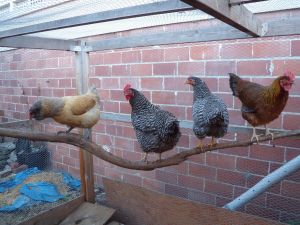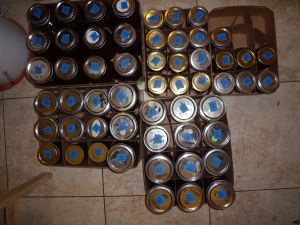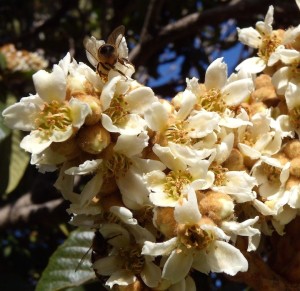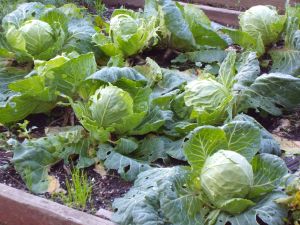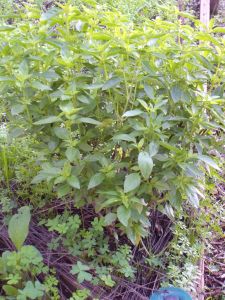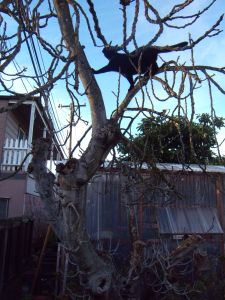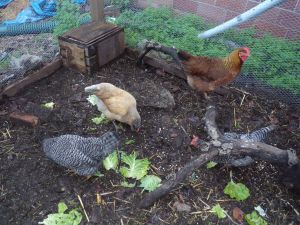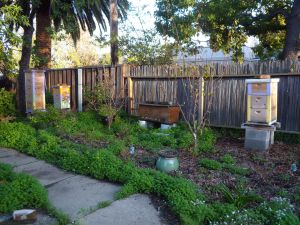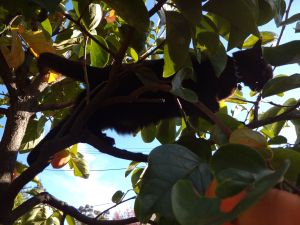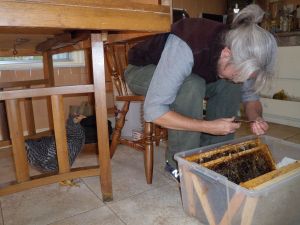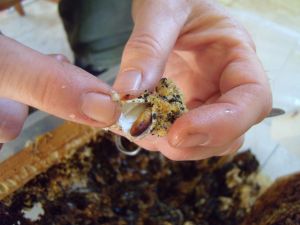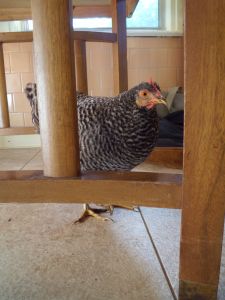I have to admit, I am having so much fun watching the total harvest pounds and dollars add up for 2015. As always, a disclaimer: we aren’t actually selling this produce–just calculating how much we would have had to spend if we had purchased it.
The raspberries and strawberries have come on earlier and stronger this year, as have the mulberries. The loquats on the other hand are abysmal; the tree appears to be dying. Kelly, being the passionate pruner that she is, is hatching plans to renovate the tree in hopes of bringing it back to some semblance of health (or at least sickly determination).
On the chicken front, Luma, now over 3 years old, is laying better than ever. One of the fun things about keeping good harvest records, is being able to remind oneself of last year’s numbers. Luma laid 17 eggs last April compared to 21 eggs this month.
Maybe it’s the treat mix Kelly lovingly concocts and sprinkles in the run each morning and evening, or maybe it’s genetic luck, but Luma is not abiding by the common wisdom that chickens stop laying after 2-3 years. You go, girl!
We continued harvesting honey in April on a frame-by frame basis. Sadly, due to California’s terrible drought, plants that would normally bloom in summer here, are blooming now. As a result, the bees had some unusual April food sources. Several of the hives were bursting with honey when I went in to inspect, and there will be May honey harvests too.
- Asparagus ‘Farmer’s Favorite’: 0.59 lbs. (@$7.99/lb.=$4.71)
- Beet ‘?’: 0.30 lbs. (@$3.98/lb=$1.19)
- Beet greens: 0.64 lbs. (@$4.98/lb.=$3.19)
- Cabbage ‘Parel’: 3.30 lbs. (@$1.49/lb.=$4.92)
- Chard ‘Fordhook’: 1.50 lbs. (@$4.98/lb.=$7.47)
- Cilantro: 0.14 lbs. (@3.58/lb.=$0.50)
- Dinosaur kale ‘Niro di Toscano’: 0.69 lbs. (@$4.98/lb.=$3.44)
- Eggs (Barred Rock 21; Welsummer 26; Ameraucana 20): 67 (@$0.37/egg=$25.07)
- Fennel ‘Perfection’: 0.08 lbs. (@$2.49/lb.=$0.20)
- Honey: 4.5 lbs. (@$10.00/lb.=$45.00)
- Kale ‘Wild Kale Blend’: 0.40 (@$4.98/lb.=$1.99)
- Kale ‘Winterbor’: 2.72 lbs. (@$4.98/lb.=$13.55)
- Lettuce ‘Heirloom Blend’: 0.12 lbs. (@$5.99/lb.=$0.72)
- Lime ‘Bearrs’: 0.56 lbs. (@$0.60/lb.?=$0.34)
- Loquat: 0.24 lbs. (@$4.99/lb.?=$1.20)
- Miner’s Lettuce: 0.29 lbs. (@$5.99/lb.?=$1.74)
- Mustard ‘Ruby Streaks’: 0.04 lbs. (@$5.99/lb.=$0.24)
- Onion ‘California Red’: 0.17 lbs. (@$2.98/lb.=$0.51)
- Onion ‘Red Amposta’: 0.19 lbs. (@$2.98/lb.=$0.57)
- Mint: 0.002 lbs. (@1.99/bunch=$1.99)
- Mulberry ‘Pakistan Fruiting’: 1.37 lbs. (@$4.99/lb.?=$6.84)
- Navel orange: 7.12 lbs. (@$2.49/lb.=$17.73)
- Oregano: 0.01 lbs. (@$1.99/bunch=$1.99)
- Parsley ‘Dark Green Italian Plain’: 0.14 lbs. (@$3.58/lb.=$0.50)
- Raspberry ‘Autumn Bliss’ ‘Autumn Britten’ ‘Tulameen’: 0.36 lbs. (@$10.64/lb.=$3.83)
- Rosemary: 0.03 lbs. (@$1.99/bunch=$1.99)
- Snap pea ‘Sugar Snap’: 0.15 lbs. (@$5.99/lb.=$0.90)
- Spinach ‘?’: 0.09 lbs. (@$5.99/lb.=$0.54)
- Spring onion ‘Purplette’: 0.31 lbs. (@$2.98/lb.=$0.92)
- Strawberry ‘Seascape’ and ‘Albion’: 3.25 lbs. (@$4.99/lb.=$16.22)
- Thyme: 0.002 lbs. (@$1.99/bunch=$1.99)
Produce total: 24.8 lbs. ($101.92)
Egg count: 67 ($25.07)
Honey: 4.5 lbs. ($45)
2015 produce total: 394.67 lbs. ($667.78)
2015 egg count: 158 ($55.10)
2015 honey harvest: 135.25 lbs. ($1352.50)
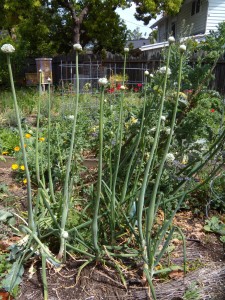
We’re letting this year-old patch of ‘Purplette’ onions go to seed. They’re our favorite, and they’re open pollinated, so we can stop buying new seed packets and save our own instead.


